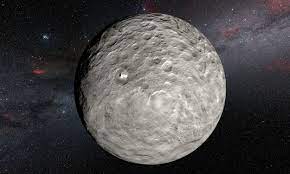Astronomers and space fans alike have been fascinated by the planet Ceres for a very long time. Ceres is the largest object in the asteroid belt that lies between Mars and Jupiter. Ceres was the very first dwarf planet to be found in our solar system, which means that it offers a one-of-a-kind chance for exploration and scientific discovery. However, the question of whether or not humans can land on Ceres still stands.
Let’s have a better understanding of the attributes of this mysterious world before we go into the question of whether or not a manned voyage to Ceres is even possible. Ceres has a diameter of approximately 590 miles (940 kilometers) and has a sizeable quantity of water ice just below its surface. Its low gravity, which is only approximately 2.8 percent of that of Earth, makes it an appealing target for potential future space expeditions.
The Dawn mission, which was operated by NASA and orbited the dwarf planet Ceres from 2015 to 2018, was responsible for making the first detailed observations of Ceres. The Dawn mission yielded important new information on Ceres’ geology, composition, and the likelihood that it could support life. The data collected by the spacecraft revealed bright patches on the planet’s surface. These bright spots turned found to be deposits of sodium carbonate, a sort of salt. This discovery points to the existence of liquid water on Ceres either in the planet’s history or possibly in its present, which raises some intriguing issues concerning the possibility of life beyond our planet.
As a result of these discoveries, the prospect of establishing a human presence on Ceres is becoming an increasingly appealing one. However, in order to accomplish such a mission, it will first be necessary to triumph over a number of substantial obstacles. The distance between Earth and Ceres can range anywhere from 257 million miles to 414 million kilometers, depending on where each body is in its own orbit in relation to the other. On average, though, it is approximately 257 million miles. This enormous distance offers logistical obstacles in the form of requirements for the amount of fuel, journey time, and provisions for the crew.
The enormous amount of energy that is needed for a spaceship to break free from the pull of Earth’s gravity and go to Ceres is one of the key challenges that must be overcome in order to reach the dwarf planet. Launching a manned mission would need the development of cutting-edge propulsion systems as well as spacecraft that are capable of transporting personnel, life support systems, and the supplies required for a lengthy journey.
The length of time that a manned mission would have to spend on Ceres would also present some difficulties. The trip time alone could take several months, or perhaps years, depending on the technology that is used for propulsion. Because of this, it would be necessary to design and implement self-sustaining life support systems in order to guarantee the crew’s health and continued existence throughout the long journey.
The actual landing is yet another huge challenge. Because Ceres does not have a strong atmosphere, any spacecraft that wishes to land safely on the surface would have to rely only on the power provided by rockets in order to slow down and land in a controlled manner. Because Ceres has a lower gravity than other celestial worlds, such as Earth or Mars, landing there would take less energy. This could be an advantage in this particular situation. Nevertheless, accurate navigation and landing capabilities would be absolutely necessary in order to guarantee a successful landing.
In spite of these obstacles, advances in technology and the ongoing exploration of space are consistently pushing the boundaries of what we consider to be conceivable. Private enterprises such as SpaceX and Blue Origin have made tremendous advancements in space technology in recent years. These companies have demonstrated reusable rockets and have big plans for deep space missions.
Furthermore, robotic exploration missions such as Dawn and future missions such as NASA’s Psyche and the European Space Agency’s Hera are paving the way by giving essential data and insights into the circumstances and problems of exploring Ceres. These missions include Dawn and Psyche and Hera.
At the moment, the idea of humans setting foot on Ceres might sound like something out of a science fiction movie, but as our knowledge of space travel expands and our technology improves, the possibility of this happening in the future is growing. The potential for human exploration of this fascinating dwarf planet can be unlocked by continued scientific exploration as well as technical innovation, both of which will play critical roles in this process.
In conclusion, despite the fact that there will be significant obstacles to overcome, it is not completely out of the question to land humans on Ceres. As we continue to push the limits of space exploration, the appeal of reaching this mysterious world and uncovering its secrets will definitely motivate us to overcome the challenges that we face along the route.
![]()
